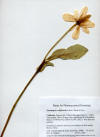|
Anemopsis californica |
Anemopsis californica |
|
Childs R. F. and J. R. Cole. 1965. Phytochemical and pharmacological investigation of Anemopsis californica. J. Pharm. Sci. 54(5): 789–791. Daniels A.L., S. van Slambrouck, R. K. Lee RK, T. S. Arguello, J. Browning,M. J. Pullin, A. Kornienko and W. F. Steelant. 2006. Effects of extracts from two Native American plants on proliferation of human breast and colon cancer cell lines in vitro. Oncol. Rep. 15(5): 1327–1331. “Native American medicinal plants are traditionally used to prevent and treat a variety of diseases, including cancer. These herbal preparations are alleged to have many biological activities, such as stimulation or suppression of immune responses and antiproliferative effects on cancer cells. In the present study, we investigated the effects of aqueous and ethanol extracts from two Native American plants, Ligusticum porteri (Osha) and Anemopsis californica (Yerba Manza), on the growth of human MCF-7/AZ breast and HCT8/E11 colon cancer cells. The aqueous and ethanol extracts from A. californica potently inhibited growth of MCF-7/AZ in a concentration-dependent manner, whereas the growth of HCT8/E11 was unaltered. Extracts from L. porteri showed no activity on either cell line. In addition, we observed that the extracellular signal-regulated protein kinase 1 and 2 (ERK1/2) activities were markedly decreased when exposed to both extracts from A. californica. These results suggest that the growth inhibitory effect of A. californica in breast cancer cells is ERK-mediated.” Medina A.L., M. E. Lucero, F. O. Holguin, R. E. Estell, J. J. Posakony, J. Simon and M. A. O'Connell 2005. Composition and Antimicrobial Activity of Anemopsis californica leaf oil. J. Agric. Food Chem. 53(22): 8694–8698. “Isolation and characterization of leaf volatiles in Anemopsis californica (Nutt.) Hook. and Arn. (A. californica) was performed using steam distillation, solid-phase microextraction, and supercritical fluid extraction. Thirty-eight compounds were detected and identified by gas chromatography; elemicin was the major component of the leaf volatiles. While the composition of the leaf volatiles varied with method of extraction, alpha-pinene, sabinene, beta-phellandrene, 1,8-cineole, piperitone, methyl eugenol, (E)-caryophyllene, and elemicin were usually present in readily detectable amounts. Greenhouse-reared clones of a wild population of A. californica had an identical leaf volatile composition with the parent plants. Steam-distilled oil had antimicrobial properties against 3 (Staphylococcus aureus, Streptococcus pneumoniae, and Geotrichim candidum) of 11 microbial species tested. Some of this bioactivity could be accounted for by the alpha-pinene in the oil.” |
|

